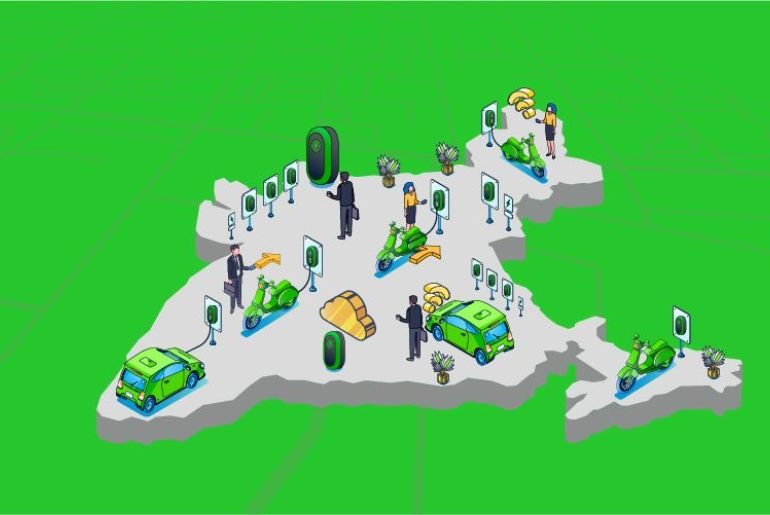Electric Vehicles (EVs) are becoming more popular around the world. They run on electricity instead of petrol or diesel, which helps reduce air pollution and saves fuel costs. But the big question is—does EV really have a bright future in India?
Why India Needs Electric Vehicles
India is one of the most polluted countries in the world. Cities like Delhi, Mumbai, and Kolkata often have poor air quality, mainly due to traffic and industrial smoke. EVs produce zero tailpipe emissions, which means they do not release harmful gases like petrol or diesel vehicles. This makes EVs a good solution to reduce pollution.
Also, India imports a large amount of crude oil every year. In the financial year 2022–23, India imported oil worth over $150 billion. EVs can help reduce this dependency by using domestic electricity, which can even be generated from solar or wind power.
Current Status of EVs in India
The EV market in India is growing. According to the government’s VAHAN portal, India saw over 15 lakh (1.5 million) EV registrations in 2023. This includes electric two-wheelers, three-wheelers, cars, and buses.
Among these, electric two-wheelers like Ola Electric, Ather Energy, TVS iQube, and Hero Vida are the most popular. This is because they are cheaper than electric cars and easier to charge at home.
Electric cars are slowly gaining popularity too. Companies like Tata Motors, MG, and Hyundai are offering electric cars like Tata Nexon EV, Tata Tiago EV, MG ZS EV, and Hyundai Kona.
Electric buses are also being used by many city governments for public transport. For example, Mumbai’s BEST and Delhi Transport Corporation (DTC) have added hundreds of electric buses to reduce pollution and fuel costs.
Government Support for EVs
The Indian government is strongly supporting EV adoption. Some of the key initiatives are:
FAME Scheme
The Faster Adoption and Manufacturing of Hybrid and Electric Vehicles (FAME) scheme provides financial incentives to buyers of EVs. The second phase, FAME II, launched in 2019, has a budget of ₹10,000 crore and focuses on supporting electric buses, three-wheelers, and two-wheelers.
State Policies
Several Indian states like Delhi, Maharashtra, Tamil Nadu, and Gujarat have their own EV policies. These offer benefits like:
- Road tax exemption
- Registration fee waiver
- Direct subsidies
- Support for charging infrastructure
Production Linked Incentive (PLI) Scheme
To boost local manufacturing, the government introduced the PLI scheme for Advanced Chemistry Cell (ACC) batteries. This helps reduce battery costs, which are the most expensive part of an EV.
Challenges for EV Growth in India
Despite the growth, there are still some challenges that India needs to overcome:
High Cost of EVs
Although prices are coming down, EVs are still costlier than regular petrol vehicles. For example, a petrol car may cost ₹7 lakh, but a similar electric car might cost ₹10 lakh. This makes people hesitant to buy EVs.
Lack of Charging Stations
Many people worry about where to charge their EVs. Charging stations are not yet available in all areas, especially in smaller towns and highways. This creates “range anxiety”—the fear that the battery will run out before reaching a charger.
Battery Recycling
EV batteries lose performance over time. India needs a good system to recycle or reuse old batteries safely. Otherwise, it could create environmental issues.
Limited Model Options
There are fewer EV models in India compared to other countries. More options in different price ranges will help more people shift to electric vehicles.
Positive Signs for the Future
Even with challenges, there are many signs that show India’s EV future looks promising:
Rising Demand
As petrol prices go up and awareness grows, more people are choosing electric vehicles. In 2023, EV sales grew by over 50% compared to the previous year.
Private Investment
Many companies are investing in EVs and charging networks. Ola, Ather, and Tata are building large EV factories. Companies like Reliance and Adani are also planning to enter the EV charging business.
Better Charging Network
The number of public charging stations is growing. According to the Bureau of Energy Efficiency (BEE), India had around 9,000 public chargers in 2023, and more are being added every month. Big cities now have charging points at malls, petrol pumps, and parking areas.
Improved Technology
Battery costs are falling, and new technologies like solid-state batteries are being developed. This will make EVs cheaper, faster to charge, and longer lasting.
Examples from Around the World
India can learn from other countries where EV adoption is high:
Norway: According to the Norwegian Road Federation (OFV), fully electric vehicles accounted for 88.9% of new passenger car sales in 2024. This happened because of heavy tax benefits and a strong charging network.
China: China is the world’s largest EV market. Companies like BYD and NIO lead the market, and the government has built millions of chargers across the country.
India is taking steps in the same direction, though it may take a few more years to reach that level.
What Needs to Be Done
To make EVs successful in India, the following steps are important:
- More affordable models for the middle class
- Fast and wide coverage of charging stations
- Better financing options like low-interest EMIs or lease plans
- Strong battery recycling policies
- Public awareness campaigns to reduce doubts and misinformation
Electric vehicles do have a promising future in India, but it will take time and effort. The government, companies, and people all have a role to play. With rising fuel prices, pollution concerns, and better technology, EVs are slowly but surely becoming the vehicles of tomorrow.
India may not be fully electric today, but the wheels have already started moving in the right direction. If the current pace continues, the day is not far when EVs will be a common sight on Indian roads—from small towns to big cities.


